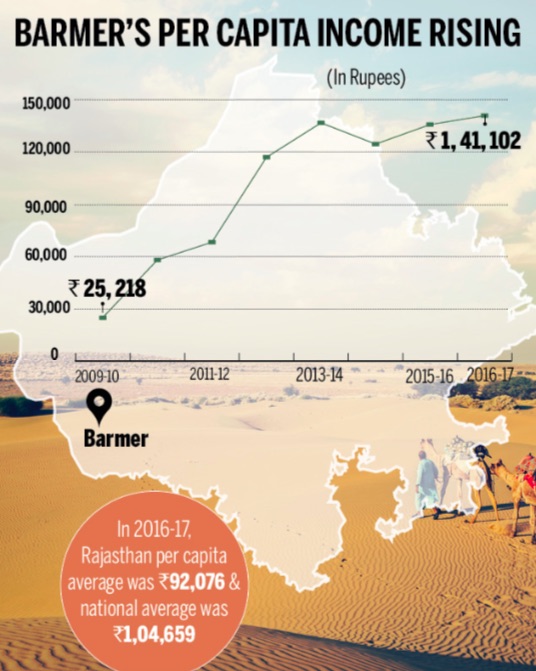Oil production: Rajasthan
This is a collection of articles archived for the excellence of their content. |
Ancillary industries
2019: a boom
Srikant Tripathy, Nov 25, 2019: The Times of India

From: Srikant Tripathy, Nov 25, 2019: The Times of India
In Barmer — heartland of Rajasthan’s crude oil production — a new generation of entrepreneurs is exploiting the growing prosperity that oil fields have brought to the region. While a 33-year-old is building a golf course in a luxury hotel he built in 2014, another is developing a chain of bunk house resorts.
Since Cairn’s gusher first started pouring out crude oil in August 2009, Barmer district has barrelled its way to the top position in the state in terms of per capita income — in 2016-17, per capita income in Barmer was Rs 1.41 lakh. The per capita income was 35% higher than even the national average of Rs 1,04,659 in 2016-17.
The drought-prone district bordering Pakistan was once known as ‘Kala Pani’, notorious for punishment postings by the state. But discovery and production of crude has attracted talent and job-seekers. The district’s contribution to the gross state domestic product (GSDP) has moved up to third position after Jaipur, challenging the number 2 industrialised Alwar that is home to heavyweights Honda, Hero MotoCorp and Saint-Gobain among others.
From contributing 2.5% to state’s GSDP of Rs 2.7 lakh crore in 2009, Barmer contributed 6.1% of state’s GSDP of Rs 7.49 lakh crore in 2016-17, according to the Directorate of Economics and Statistics, Rajasthan.
In 2017-18, Rajasthan contributed 45% of India’s total onshore crude oil production. The past decade saw malls with billiard tables and bowling alleys crop up, hotels, English-medium private schools, swanky eating joints, coaching centres, six-lane roads, flyovers, branches of almost all banks and insurance companies, dealerships of most auto majors and big apparel and accessory brands mushroom across Barmer.
A government medical college opened in the district last year. And education too is improving, albeit slowly. From a pupil-teacher ratio that was among the poorest — one teacher for 36 students in primary schools, Barmer's ratio gone up to 30 in the past three years, according to data provided by Rajasthan Council of School Education.
As Mahesh Panpalia, head of Dhaara Sansthan, a Barmer-based NGO, put it, Barmer transformed from being a “dust bowl” to a “bustling oil town”. Entrepreneurial dreams started to take wing. When Pravin Singh Sodha returned to Barmer in 2009 after completing his studies in Mumbai, he became a service provider to firms like Halliburton and Xtreme Drilling. Now he is developing a golf course in a luxury hotel he built in 2014.
A 90-minute drive from Barmer, a container resort near Gudamalani caters to officials of Schlumberger. The containers are iron houses with all facilities and are easily transportable. Owner Lalit Kiri, 40, has his eyes set on a bigger dream — to build a chain of bunk-house resorts stretching from the sand dunes to the shore.
“I was doing odd jobs in Oman but returned to Barmer after I fell sick. I thought my career was over but I managed a small contract to supply water bottles, stationery and cab services to a drilling firm. Business went well. I then started manufacturing container houses. The result is in front of you,” Kiri chuckled, owner of a bunk-house resort.
Then there’s Azad Singh, 37, who switched working at his family’s pharmacies to start a company that provides office and living spaces to professionals engaged in various oil drilling activities. But it’s not just these new companies that seem to have hit the jackpot.
Thirty kilometres from Rajasthan’s Barmer town, the once-nondescript Kawas village is prime real estate today. The bajra-growing population is putting down its crop cutter machines to play host to paying guests and tenants. Pucca houses have replaced huts and many households own cars.
When onshore oil reserves were discovered in 2004 in the Thar desert, rigs were set up 10 km from Kawas village, sending security personnel, plumbers and electricians to the hamlet and nearby areas, seeking spaces to rent.
And yet, infrastructure is hobbling — a crucial water crisis a perennial issue. A 2016 report by panchayati raj ministry tagged Barmer as among the country’s 250 Most Backward Districts. Drinking water was not available in 1,300 villages and hamlets identified this year in the sprawling district, India’s fifth largest. Water supplied in tankers barely reached 450 villages. Droughts a constant concern, locals farm crops that use less water: bajra, guar, moong and cumin.
“Droughts are frequent. Lack of medical facilities in rural areas is an issue. Teacher-student ratio in government schools is rising but quality of teaching needs much improvement,” said Panpalia.
State petroleum and mines minister Pramod Jain Bhaya, however, believes change is on its way. “Oil discovery has given people hope they no longer need migrate in search of work but a lot of work needs to be done, especially making water available to people.”
HOW BLACK GOLD WAS DISCOVERED
After exploring unsuccessfully for about five years, Royal Dutch Shell sold the fields to its minor equity partner Cairn India, a subsidiary of Cairn Energy, in 2002. Sources in the company said that Mike Watts, maverick exploration director and deputy CEO of Cairn India, was not deterred by the failures. His hunch of a potential reserve took him through the 16th drilling well when he finally hit the jackpot. Since 2009, cumulatively, the fields have produced over 550 million barrels of crude oil, saving foreign exchange worth Rs 1.85 lakh crore.
Figures provided by Cairn Oil & Gas for 2018 show that the oil fields of Cairn have generated revenues of Rs 61,050 crore for the Centre and over Rs 30,000 crore for the Rajasthan government, while creating about 7,400 jobs for locals alone. A crude oil refinery is under development by Hindustan Petroleum Corporation Ltd at the cost of Rs 43,000 crore.